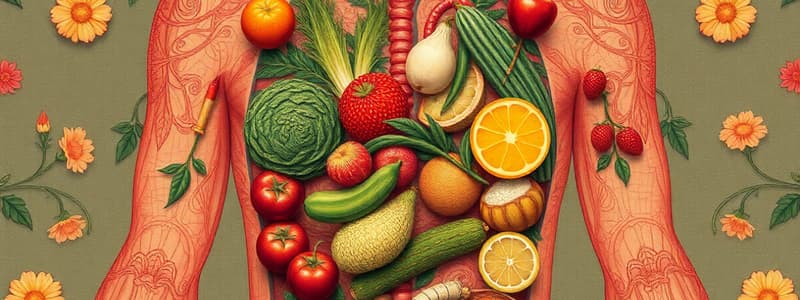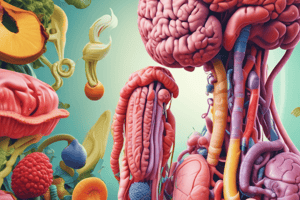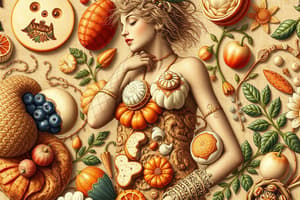Podcast
Questions and Answers
What is the primary function of absorption in the nutrient process?
What is the primary function of absorption in the nutrient process?
- Removal of undigested matter
- Transport of nutrients into the bloodstream (correct)
- Breakdown of food into small particles
- Utilization of nutrients by cells
Which process involves the rhythmic contraction of muscles in the alimentary canal?
Which process involves the rhythmic contraction of muscles in the alimentary canal?
- Egestion
- Assimilation
- Peristalsis (correct)
- Digestion
Which of the following best describes chemical digestion?
Which of the following best describes chemical digestion?
- Egestion of waste matter
- Absorption of soluble molecules
- Mechanical breakdown of food
- Enzymatic breakdown of large molecules (correct)
What role does salivary amylase play in the mouth during digestion?
What role does salivary amylase play in the mouth during digestion?
In which part of the digestion process does physical digestion mainly occur?
In which part of the digestion process does physical digestion mainly occur?
Which structure is NOT part of the alimentary canal?
Which structure is NOT part of the alimentary canal?
What substance does the stomach secrete to aid in digestion?
What substance does the stomach secrete to aid in digestion?
What is the main function of the liver in the digestive system?
What is the main function of the liver in the digestive system?
What role does hydrochloric acid serve in the gastric juices?
What role does hydrochloric acid serve in the gastric juices?
Which substances make up pancreatic juice?
Which substances make up pancreatic juice?
What is the primary function of bile in the digestive process?
What is the primary function of bile in the digestive process?
What is the digestion sequence for carbohydrates in the alimentary canal?
What is the digestion sequence for carbohydrates in the alimentary canal?
How do intestinal enzymes assist in the digestive process?
How do intestinal enzymes assist in the digestive process?
What is the role of mucus in gastric juices?
What is the role of mucus in gastric juices?
What trigger leads to the release of pancreatic juice?
What trigger leads to the release of pancreatic juice?
What substances do digestive enzymes for fats produce?
What substances do digestive enzymes for fats produce?
What is the primary function of bile salts in the digestion of fats?
What is the primary function of bile salts in the digestion of fats?
Which of the following substances are absorbed in the small intestine?
Which of the following substances are absorbed in the small intestine?
What is a key structural adaptation of the villi in the small intestine?
What is a key structural adaptation of the villi in the small intestine?
How are glucose and amino acids primarily absorbed in the small intestine?
How are glucose and amino acids primarily absorbed in the small intestine?
What occurs during the process of assimilation?
What occurs during the process of assimilation?
What role does the hepatic portal vein play in the digestive system?
What role does the hepatic portal vein play in the digestive system?
What is the end product of lipid digestion by lipase enzymes?
What is the end product of lipid digestion by lipase enzymes?
Which adaptation helps maintain a steep diffusion gradient for nutrient absorption in the villi?
Which adaptation helps maintain a steep diffusion gradient for nutrient absorption in the villi?
What is the primary function of the liver in relation to glucose when there is an excess supply?
What is the primary function of the liver in relation to glucose when there is an excess supply?
During tissue respiration, what is glucose primarily converted into?
During tissue respiration, what is glucose primarily converted into?
What is the correct definition of deamination?
What is the correct definition of deamination?
Which hormone secreted by the pancreas helps convert excess glucose into glycogen?
Which hormone secreted by the pancreas helps convert excess glucose into glycogen?
What happens to amino acids that are in excess and enter the liver?
What happens to amino acids that are in excess and enter the liver?
What role does the liver play during times of glucose scarcity?
What role does the liver play during times of glucose scarcity?
Which of the following is NOT one of the main functions of the liver?
Which of the following is NOT one of the main functions of the liver?
What is a potential harmful effect of excessive alcohol consumption on the digestive system?
What is a potential harmful effect of excessive alcohol consumption on the digestive system?
Flashcards are hidden until you start studying
Study Notes
Definition of Nutrition
- Nutrition is the process through which organisms obtain food and energy necessary for growth, repair, and maintenance of the body.
Components of Nutrition
- Ingestion: Intake of food into the body.
- Digestion: Breakdown of large food molecules into smaller, soluble molecules for absorption.
- Absorption: Movement of nutrients from the small intestine into the bloodstream.
- Assimilation: Utilization of nutrients by cells for energy or growth.
- Egestion: Elimination of undigested matter from the body.
Organs of the Alimentary Canal
- Mouth
- Oesophagus
- Stomach
- Small intestine
- Large intestine
- Anus
Essential Digestive Organs
- Liver
- Gall bladder
- Pancreas
Digestion Overview
- Digestion involves breaking down large food molecules into smaller soluble molecules for absorption, occurring in two types:
- Physical Digestion: Mechanical breakdown of food into smaller particles.
- Chemical Digestion: Enzymatic breakdown of molecules into smaller absorbable units.
Peristalsis
- Rhythmic, wave-like muscle contractions in the alimentary canal that propel food forward.
- Circular muscles contract while longitudinal muscles relax, and vice versa to facilitate movement.
Mouth Processes
- Salivary glands secrete amylase to digest starch into maltose.
- Chewing reduces food size to increase surface area for enzyme action.
- Peristalsis occurs in the oesophagus to move food.
Stomach Processes
- Peristalsis in the stomach walls churns food and mixes it with gastric juices.
- Gastric juices contain hydrochloric acid (activates protease and kills pathogens), protease (digests proteins), and mucus (protects stomach lining).
Chyme
- Chyme is the partially digested, liquefied food that moves to the duodenum.
Small Intestine Processes
- Peristalsis moves chyme through the small intestine.
- Pancreas secretes pancreatic juice, containing amylase, protease, and lipase, into the duodenum.
- Gall bladder releases bile, which contains bile salts that emulsify fats but lacks digestive enzymes.
- Epithelial cells produce maltase, protease, and lipase.
Alkaline Nature of Digestive Fluids
- Alkaline fluids (pancreatic juice, intestinal enzymes, bile) neutralize chyme and create a suitable environment for enzyme activity.
Digestive Enzymes
- Carbohydrates: Amylase, maltase (digest starch into glucose).
- Proteins: Proteases (digest proteins into amino acids).
- Fats: Lipases (digest fats into fatty acids and glycerol).
Digestion Summary
- Carbohydrates: Starch → Maltose → Glucose.
- Proteins: Proteins → Polypeptides → Amino Acids.
- Fats: Fats → Fatty Acids & Glycerol.
Absorption
- Absorption is the process where digested nutrients enter body cells.
- Nutrients absorbed in the small intestine include simple sugars, amino acids, fatty acids, glycerol, water, and mineral salts.
Adaptations of the Small Intestine for Absorption
- Villi increase surface area for nutrient absorption.
- Epithelial cells are one cell thick for short diffusion distance.
- Blood capillaries in villi transport absorbed nutrients, maintaining a diffusion gradient.
- Lacteals transport absorbed fats.
- Mitochondria in epithelial cells provide energy for active transport.
Nutrient Absorption
- Glucose and amino acids are absorbed through diffusion and active transport.
- Fatty acids and glycerol diffuse into the epithelium and form fat globules entering lacteals.
Assimilation
- Assimilation converts absorbed nutrients into new cytoplasm and energy.
Hepatic Portal Vein
- Transports nutrients from the small intestine to the liver.
Glucose Assimilation
- Glucose is used for energy or stored as glycogen in the liver for later use.
Amino Acid Assimilation
- Amino acids are used for growth and repair; excess undergo deamination in the liver.
Fats in the Liver
- Fats build protoplasm when glucose is sufficient; if glucose is low, fats provide energy.
- Excess fats are stored in adipose tissues.
Liver Functions
- Produces bile, deaminates amino acids, regulates blood glucose, breaks down hormones, detoxifies substances.
Deamination
- Removal of amino groups from amino acids, converting them into urea.
Blood Glucose Regulation
- Pancreas releases insulin (converts excess glucose to glycogen) and glucagon (converts glycogen back to glucose).
Harmful Effects of Alcohol Consumption
- Digestive: Increases stomach acid, risk of ulcers, leads to liver cirrhosis.
- Nervous: Slows reactions, affects judgment, risks dementia and brain shrinkage.
Studying That Suits You
Use AI to generate personalized quizzes and flashcards to suit your learning preferences.




